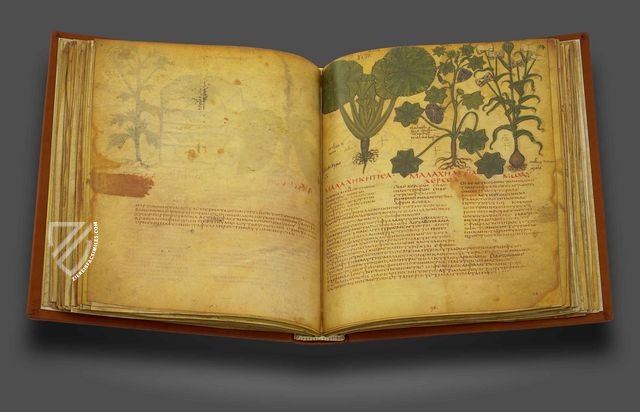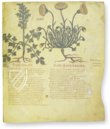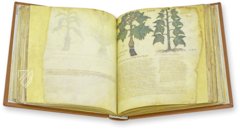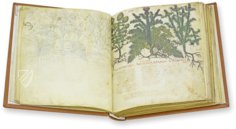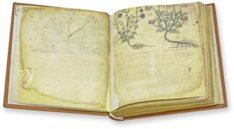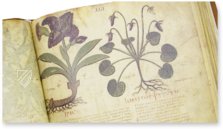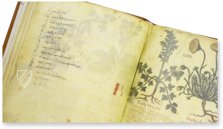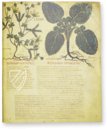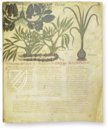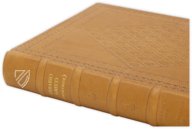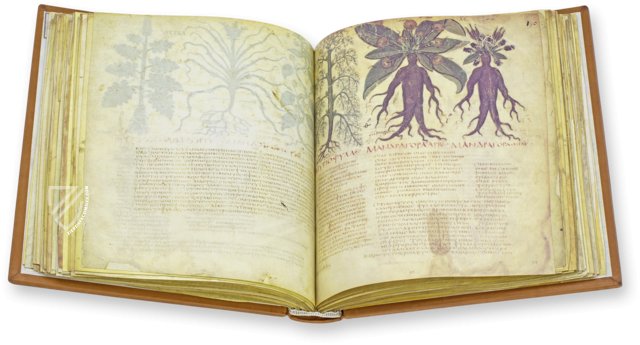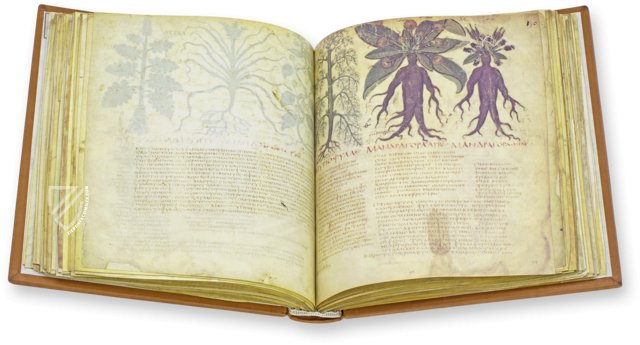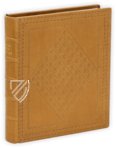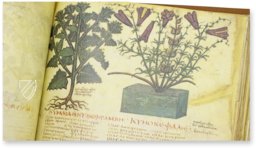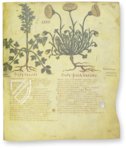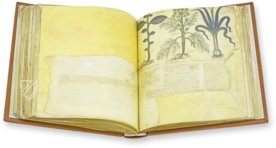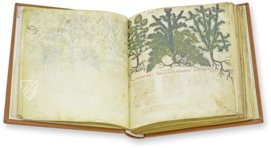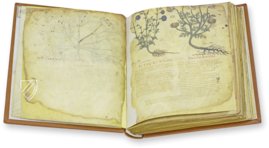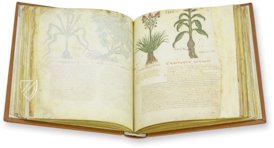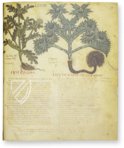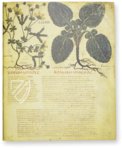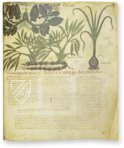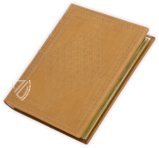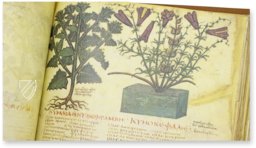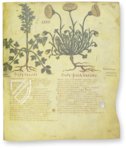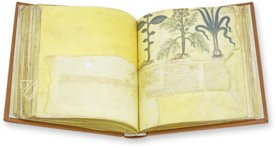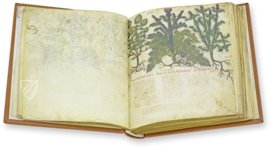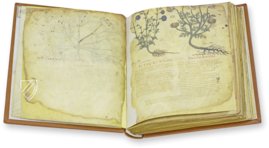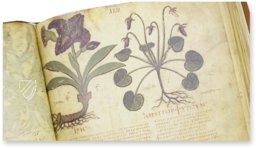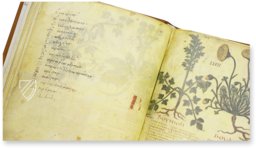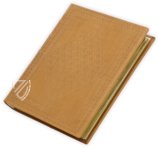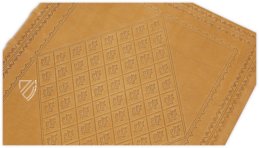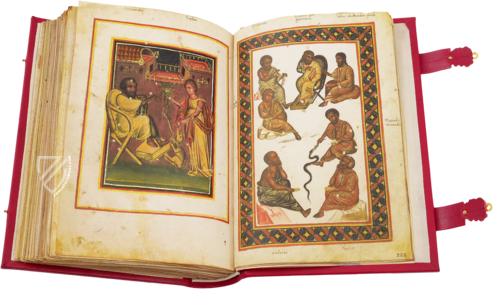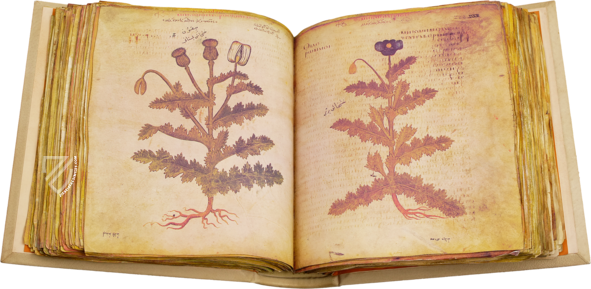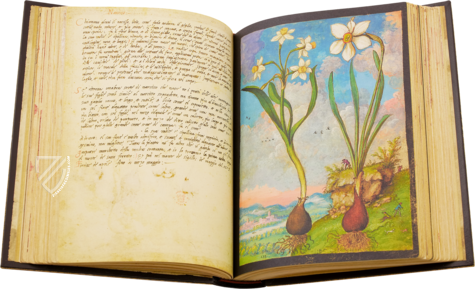Naples Dioscorides
(3,000€ - 7,000€)
The Dioscorides Neapolitanus: a pharmacological work for the ages! Written by the Greek surgeon Pedanius Dioscorides in the 1st century A.D., the primary significance of Dioscorides as a major authority in his field is evidenced by the wide spread use of his work over the centuries, and translation thereof into many languages. Made either in Byzantium or southern Italy, it contains 403 miniatures depicting different plants and gives unique testimony to the unmatched virtuosity of the illuminators of this period. This codex goes beyond being a work of art, and was actually designed to be used as efficiently as possible as a practical reference work with its contents listed alphabetically and written in clear, Bible majuscule, chosen for its easy legibility. This is one of the most important texts for botany and medicine to ever be written and is presented here in a superb luxury manuscript.
Naples Dioscorides
The Codex Neapolitanus is one of the oldest manuscripts in the tradition of Materia Medica, the leading pharmacological work of Greco-Roman times, written by the Greek surgeon Pedanius Dioscorides in the 1st century A.D. The eminent role of this codex is not least due to the great number of botanical illustrations and descriptions of plants in all their details. The primary significance of Dioscorides as a major authority in his field is evidenced by the wide spread use of his work over the centuries. In the 6th century, it was translated into Latin and from the 9th century, it was translated and edited into Arabic, Syrian, and Hebrew as well. Materia Medica thus remained the pharmacological reference work and was read not only by physicians and botanists but also by interested lay botanists. The Dioscorides Neapolitanus can be dated to the early 7th century, although research still varies as to whether it was made in Byzantium or Italy. G. Cavallo suggests that the miniatures in the manuscript were obviously a product of the activity of Greek artists in Italy. The 403 miniatures depict different plants and bear unique testimony to the unmatched virtuosity of the illuminators of this period.
The Miniatures
The botanical illustrations in the Codex Neapolitanus, according to some, are not originals of early Byzantine book illumination but rather constitute copies of more ancient models which are probably based on the Herbolarium by Crateuas, a source used by Dioscorides, and thus go back to the Alexandrian or Pergamenes textbook illustrations of the two centuries before Christ. In a successful didactic approach, one to three illustrations of plants are found in the upper half of each recto page and described in the text below. The verso pages are, however, mostly left blank or carry only additional text, in the attempt to avoid possible interference with the picture composition due to color showing through the vellum. The font used is the so-called Bible majuscule, a square type appreciated for its easy legibility. The division of the text into two columns also guarantees easy use. Below the botanical illustrations, the names of plants were added in red ink, thus keeping to a very synoptic layout. Later annotations added throughout the manuscript justify the great esteem for the Codex Neapolitanus which was frequently used over the centuries. Even today, Dioscorides is referred to in context with certain plants and drugs.
A Physician’s Reference Work
Dioscorides examines one plant per chapter. Its designation and synonyms are followed by a description of its properties as well as information on its origin and effect, preparation, use and dosage. The work, whose significance applies both to the fields of botany and pharmacology, was above all conceived of as a textbook on drugs for use by physicians. A striking feature of the Codex Neapolitanus is the lexical rearrangement of its contents in alphabetical order. The systematic order according to the therapeutic properties of plants was supplanted to enable users finding their way round the book as quickly as possible.
The History of the Manuscript
We know little about the history of the manuscript. Until the early 18th century, it was kept in the Augustinian Monastery of San Giovanni a Carbonara in Naples. In 1718, the Habsburgs took it back with them to the Viennese Court Library, and the codex was returned to Naples in 1919 following the conclusion of the peace negotiations after World War I, this time to the Biblioteca Nazionale, and now belongs to the most precious gems of this richly stocked library.
Codicology
- Alternative Titles
- Dioskurides Neapolitanus
Dioskurides von Neapel - Size / Format
- 344 pages / 29.5 × 25.0 cm
- Origin
- Italy
- Date
- Beginning of the 7th century
- Epochs
- Style
- Language
- Script
- Biblical Greek majuscule
- Illustrations
- 403 miniatures
- Content
- The leading pharmacological work of Greco-Roman times
- Previous Owners
- Augustine Monastery of St. Giovanni a Carbonara in Naples
Habsburg family
#1 Dioskurides Neapolitanus
Languages: English, German, Italian
(3,000€ - 7,000€)
#2 Dioscurides Neapolitanus
Language: Italian
(3,000€ - 7,000€)
- Treatises / Secular Books
- Apocalypses / Beatus
- Astronomy / Astrology
- Bestiaries
- Bibles / Gospels
- Chronicles / History / Law
- Geography / Maps
- Saints' Lives
- Islam / Oriental
- Judaism / Hebrew
- Single Leaf Collections
- Leonardo da Vinci
- Literature / Poetry
- Liturgical Manuscripts
- Medicine / Botany / Alchemy
- Music
- Mythology / Prophecies
- Psalters
- Other Religious Books
- Games / Hunting
- Private Devotion Books
- Other Genres
- Afghanistan
- Armenia
- Austria
- Belgium
- Colombia
- Croatia
- Cyprus
- Czech Republic
- Denmark
- Egypt
- Ethiopia
- France
- Germany
- Greece
- Hungary
- India
- Iran
- Iraq
- Israel
- Italy
- Japan
- Lebanon
- Luxembourg
- Mexico
- Morocco
- Netherlands
- Palestine
- Peru
- Poland
- Portugal
- Russia
- Serbia
- Spain
- Sri Lanka
- Sweden
- Switzerland
- Syria
- Turkey
- Ukraine
- United Kingdom
- United States
- Uzbekistan
- Aboca Museum
- Ajuntament de Valencia
- Akademie Verlag
- Akademische Druck- u. Verlagsanstalt (ADEVA)
- Aldo Ausilio Editore - Bottega d’Erasmo
- Alecto Historical Editions
- Alkuin Verlag
- Almqvist & Wiksell
- Amilcare Pizzi
- Andreas & Andreas Verlagsbuchhandlung
- Archa 90
- Archiv Verlag
- Archivi Edizioni
- Arnold Verlag
- ARS
- Ars Magna
- ArtCodex
- AyN Ediciones
- Azimuth Editions
- Badenia Verlag
- Bärenreiter-Verlag
- Belser Verlag
- Belser Verlag / WK Wertkontor
- Benziger Verlag
- Bernardinum Wydawnictwo
- BiblioGemma
- Biblioteca Apostolica Vaticana (Vaticanstadt, Vaticanstadt)
- Bibliotheca Palatina Faksimile Verlag
- Bibliotheca Rara
- Boydell & Brewer
- Bramante Edizioni
- Bredius Genootschap
- Brepols Publishers
- British Library
- C. Weckesser
- Caixa Catalunya
- Canesi
- CAPSA, Ars Scriptoria
- Caratzas Brothers, Publishers
- Carus Verlag
- Casamassima Libri
- Chavane Verlag
- Christian Brandstätter Verlag
- Circulo Cientifico
- Club Bibliófilo Versol
- Club du Livre
- CM Editores
- Collegium Graphicum
- Collezione Apocrifa Da Vinci
- Comissão Nacional para as Comemorações dos Descobrimentos Portugueses
- Coron Verlag
- Corvina
- CTHS
- D. S. Brewer
- Damon
- De Agostini/UTET
- De Nederlandsche Boekhandel
- De Schutter
- Deuschle & Stemmle
- Deutscher Verlag für Kunstwissenschaft
- DIAMM
- Droz
- E. Schreiber Graphische Kunstanstalten
- Ediciones Boreal
- Ediciones Grial
- Ediclube
- Edições Inapa
- Edilan
- Editalia
- Edition Deuschle
- Edition Georg Popp
- Edition Leipzig
- Edition Libri Illustri
- Editiones Reales Sitios S. L.
- Éditions de l'Oiseau Lyre
- Editions Medicina Rara
- Editorial Casariego
- Editorial Mintzoa
- Editrice Antenore
- Editrice Velar
- Edizioni Edison
- Egeria, S.L.
- Eikon Editores
- Electa
- Emery Walker Limited
- Enciclopèdia Catalana
- Eos-Verlag
- Ephesus Publishing
- Ernst Battenberg
- Eugrammia Press
- Extraordinary Editions
- Fackelverlag
- Facsimila Art & Edition
- Facsimile Editions Ltd.
- Facsimilia Art & Edition Ebert KG
- Faksimile Verlag
- Feuermann Verlag
- Folger Shakespeare Library
- Franco Cosimo Panini Editore
- Friedrich Wittig Verlag
- Fundación Hullera Vasco-Leonesa
- G. Braziller
- Gabriele Mazzotta Editore
- Gebr. Mann Verlag
- Gesellschaft für graphische Industrie
- Getty Research Institute
- Giovanni Domenico de Rossi
- Giunti Editore
- Graffiti
- Grafica European Center of Fine Arts
- Guido Pressler
- Guillermo Blazquez
- Gustav Kiepenheuer
- H. N. Abrams
- Harrassowitz
- Helikon
- Hendrickson Publishers
- Henning Oppermann
- Herder Verlag
- Hes & De Graaf Publishers
- Hoepli
- Holbein-Verlag
- Hortus Deliciarum
- Houghton Library
- Hugo Schmidt Verlag
- Idion Verlag
- Il Bulino, edizioni d'arte
- ILte
- Imago
- Insel Verlag
- Instituto Nacional de Antropología e Historia
- Istituto dell'Enciclopedia Italiana - Treccani
- Istituto Ellenico di Studi Bizantini e Postbizantini
- Istituto Geografico De Agostini
- Istituto Poligrafico e Zecca dello Stato
- Italarte Art Establishments
- J. Thorbecke
- Jan Thorbecke Verlag
- Johnson Reprint Corporation
- Josef Stocker
- Josef Stocker-Schmid
- Jugoslavija
- Karl W. Hiersemann
- Kasper Straube
- Kaydeda Ediciones
- Kindler Verlag / Coron Verlag
- Kodansha International Ltd.
- Konrad Kölbl Verlag
- Kurt Wolff Verlag
- La Liberia dello Stato
- La Linea Editrice
- La Meta Editore
- Lambert Schneider
- Landeskreditbank Baden-Württemberg
- Leo S. Olschki
- Les Incunables
- Library of Congress
- Libreria Musicale Italiana
- Lichtdruck
- Lito Immagine Editore
- Lumen Artis
- Lund Humphries
- M. Moleiro Editor
- Maison des Sciences de l'homme et de la société de Poitiers
- Manuscriptum
- Martinus Nijhoff
- Maruzen-Yushodo Co. Ltd.
- MASA
- McGraw-Hill
- Militos
- Millennium Liber
- Müller & Schindler
- Nahar and Steimatzky
- National Library of Wales
- Neri Pozza
- Nova Charta
- Oceanum Verlag
- Odeon
- Orbis Mediaevalis
- Orbis Pictus
- Österreichische Staatsdruckerei
- Oxford University Press
- Pageant Books
- Parzellers Buchverlag
- Patrimonio Ediciones
- Pattloch Verlag
- PIAF
- Pieper Verlag
- Plon-Nourrit et cie
- Prestel Verlag
- Princeton University Press
- Prisma Verlag
- Priuli & Verlucca, editori
- Pro Sport Verlag
- Propyläen Verlag
- Pytheas Books
- Quaternio Verlag Luzern
- Reales Sitios
- Recht-Verlag
- Reichert Verlag
- Reichsdruckerei
- Riehn & Reusch
- Roberto Vattori Editore
- Rosenkilde and Bagger
- Roxburghe Club
- Salerno Editrice
- Sarajevo Svjetlost
- Schöck ArtPrint Kft.
- Scolar Press
- Scrinium
- Scripta Maneant
- Scriptorium
- Siloé, arte y bibliofilia
- SISMEL - Edizioni del Galluzzo
- Sociedad Mexicana de Antropología
- Société des Bibliophiles & Iconophiles de Belgique
- Soncin Publishing
- Sorli Ediciones
- Stainer and Bell
- Studer
- Styria Verlag
- Sumptibus Pragopress
- Szegedi Tudomànyegyetem
- Taberna Libraria
- Tarshish Books
- Taschen
- Tempus Libri
- Testimonio Compañía Editorial
- Thames and Hudson
- The Clear Vue Publishing Partnership Limited
- The Facsimile Codex
- The Folio Society
- The Marquess of Normanby
- The Richard III and Yorkist History Trust
- Tip.Le.Co
- TouchArt
- TREC Publishing House
- TRI Publishing Co.
- Trident Editore
- Typis Regiae Officinae Polygraphicae
- Union Verlag Berlin
- Universidad de Granada
- University of California Press
- University of Chicago Press
- Urs Graf
- Vallecchi
- Van Wijnen
- VCH, Acta Humaniora
- VDI Verlag
- VEB Deutscher Verlag für Musik
- Verlag Anton Pustet / Andreas Verlag
- Verlag Bibliophile Drucke Josef Stocker
- Verlag der Münchner Drucke
- Verlag für Regionalgeschichte
- Verlag Styria
- Vicent Garcia Editores
- W. Turnowsky
- Waanders Printers
- Wiener Mechitharisten-Congregation (Wien, Österreich)
- Wissenschaftliche Buchgesellschaft
- Wydawnictwo Dolnoslaskie
- Xuntanza Editorial
- Zakład Narodowy
- Zollikofer AG

